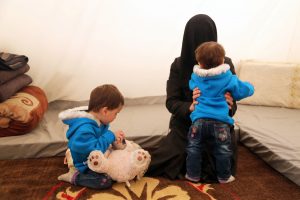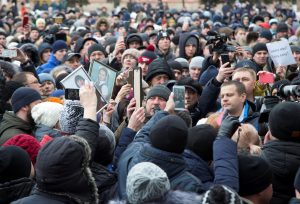
By Dahlia Nehme
BEIRUT (Reuters) – Muayad al-Dirani was at a medical center in the Syrian town of Douma the night of April 7, when patients started flowing in.
Many of them were suffocating or having seizures, after a suspected poison gas attack struck the rebel enclave.
Doctors hurried to undress victims, douse them in water, and give atropine injections, he said. But they could not keep up. “Everyone lost their nerves, felt helpless and didn’t know what to do,” Dirani said. “The aircraft was still in the sky.”

Rasha Edlibi, a survivor of the suspected poison gas attack, sits with her two daughters inside a tent for the displaced, in the Northern Aleppo countryside, Syria April 17, 2018. Picture taken April 17, 2018. REUTERS/Mahmoud Hassano
Rasha Edlibi, a survivor of the attack, said the gas left her unable to breathe and made her eyes well up with tears.
“We were in the basement, around dinner time, when there was a lot of bombardment, and we felt a very, very strong chlorine smell,” she said. “Before I knew it, my husband was carrying me to a (medical) point. I woke up to them throwing water on me.”
The medics were already working at full capacity after weeks of army artillery and air strikes, said Dirani, 20, a photographer who was working to document the victims of attacks during the conflict.
He grabbed his camera, put on a face mask, and ran with emergency workers to the nearby site of the attack, he said.
“On the way, we saw corpses in the street…They had tried to flee and didn’t make it.”
Medical relief groups say dozens of men, women, and children were gassed to death in Douma that night. Damascus and its key ally Moscow have dismissed the reports of a chemical attack.
The United States, France, and Britain launched missile strikes on Saturday over the suspected chemical attack, the first coordinated direct Western military action against President Bashar al-Assad in seven years of war.
The suspected gas attack took place during the final days of a government offensive on Douma, the last town to hold out in the eastern Ghouta enclave that the army has recaptured since February.
Dirani spoke to Reuters in a telephone interview from rebel territory in northern Syria, where thousands of insurgent fighters and civilians from Douma were sent in an evacuation under a surrender deal with the government.
Dirani said when he reached the site of the attack, he found nearly 30 bodies on the ground floor, and a few others on the first. Their eyes were open and foam had come out of their mouths, he said.
“There was no place for us to walk…They looked terrifying.”
He stopped taking pictures of the victims and rushed outside to get first aid, after his eyes burnt and his breath got short. Dirani said he was also coughing and felt a pain at the bottom of his stomach.
“The scenes I saw do not leave my mind, and they will never be erased from my memory,” he said.
He recalled the sight of a child twitching on the floor, being sprayed with water and being given oxygen. We were “waiting for him to get better or die”, he said.
“Everyone was crying, the medical staff were crying and I was also, and we couldn’t do anything.”
Rescue workers went out the next morning to look for more bodies, and people buried the dead a few days later.
Douma is located in the Ghouta region near Damascus where three towns were hit in a nerve gas attack that killed hundreds of people in 2013.
Edlibi said one of her two young daughters “turned blue right away” because she already had lung problems from previous shelling. She spoke to Reuters at a camp for the displaced in rebel-held territory in northern Syria.
“I still have trouble breathing till now and the headache is not going away,” she said.
(Editing by Ellen Francis, Tom Perry and Peter Graff)









